Pearl of Fortresses that Perched on a rocky outcrop-The Gwalior Fort
Gwalior Fort
Gwalior fort is delighted with its great history and melodic music. It is dotted with plain and hilly landscapes and holds an important place in the heart of incredible India. The hilltop fort, which was famously described as ‘The pearl amongst fortresses in India’ is the testimony of dynasties that ruled over the decades. Gwalior Fort’s covered domes, giant faded doors, and carved walls, looming over the old city of Gwalior, have withstood everything that came their way. Gwalior Fort is also considered to be one of the most impenetrable forts in the country. Known for its great architecture and rich past. Having served as the seat of several dynasties all through history, the city of Gwalior can be best described as the glittering gem of Madhya Pradesh. The city owes its regal status to the ancient forts and many temples. Having stood the test of time, Gwalior puts on display the best of art and valour. The city’s monuments are a testament to the valor of the rulers who once wore the crown.
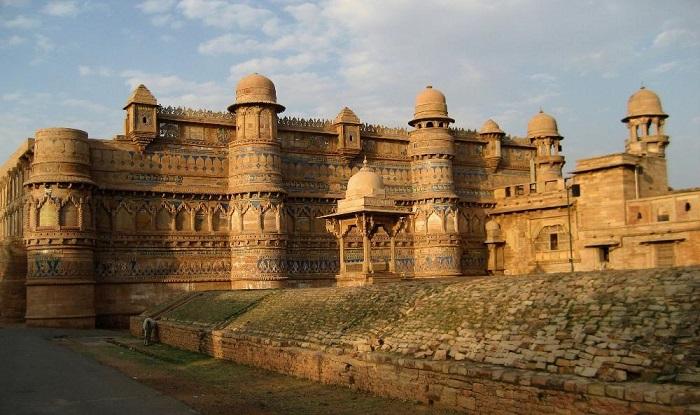
The history of the Gwalior Fort
According to historians, the Gwalior fort was built in 3 CE by a local king called Suraj Sen, however, Certain monuments and inscriptions inside the fort explain that it has existed since the 6th century. An Huna emperor called Mihirakula used to rule the fort during that time. There is a myth about King Suraj Sen. It is said that A saint named Gwalipa came wandering to the fort and met the king, who was suffering from leprosy. When Gwalipa offered him some water from a sacred pond (now called Suraj Kund located within the fort complex), he immediately became healthy. As a thankful gesture to the saint, the king named the fort and the Gwalior town after him. The saint then gave the king the title of ‘Pal’ (protector) and told him that as long as he and his family continue to bear this title, the fort would remain in their possession. Following this, 83 successors of Suraj Sen controlled the fort. But the 84th king, Tej Karan, did not bear the title and lost control of the fort.
Later in the 9th century, Gurjara-Pratiharas captured the fort, governed, and also built the Teli Ka Mandir. After Gurjara-Pratiharas’ reign, the fort was captured by, the Tomars in 1398. Maan Singh was the last and the most distinguished Tomar ruler, and he constructed several monuments inside the fort complex. The beautiful turquoise blue-tiled Man Mandir Palace was built during his reign. And Maan Singh also had a separate palace built for his wife Mrignayani; this structure is called the Gujari Mahal and is now a state archaeological museum.
The Gwalior Fort then witnessed a brief period of rule by the Mughals dynasty, until the Marathas captured it and soon lost it to the East India Company. After this, there were many recurrent shifts between the rule of the Marathas and the Britishers. Finally, in 1844, the Maratha Scindia family of Gwalior occupied the fort under the protectorate of the British government. During the rebellion of 1857, the fort saw great warfare in Indian history. Rani Lakshmibai (the Queen of Jhansi) came fighting from Jhansi to Gwalior and occupied the fort. After fighting for days with the Britishers, she sacrificed her life.
The structure of the Gwalior Fort
The fort complex includes several temples, palaces, and water tanks with well-maintained premises. The Fort area includes the Man Mandir Palace, the Gujari Mahal, the Jahangir Mahal, the Shah Jahan Mahal, and the Karan Mahal. The fort lies on an area of 3 square kilometers and has two entrance gates-
The main entrance is the Elephant Gate (Hathi Pol) on the northeast side with a long ramp.
Badalgarh Gate is on the southwest side while Man Mandir Palace sits on the northeast side.
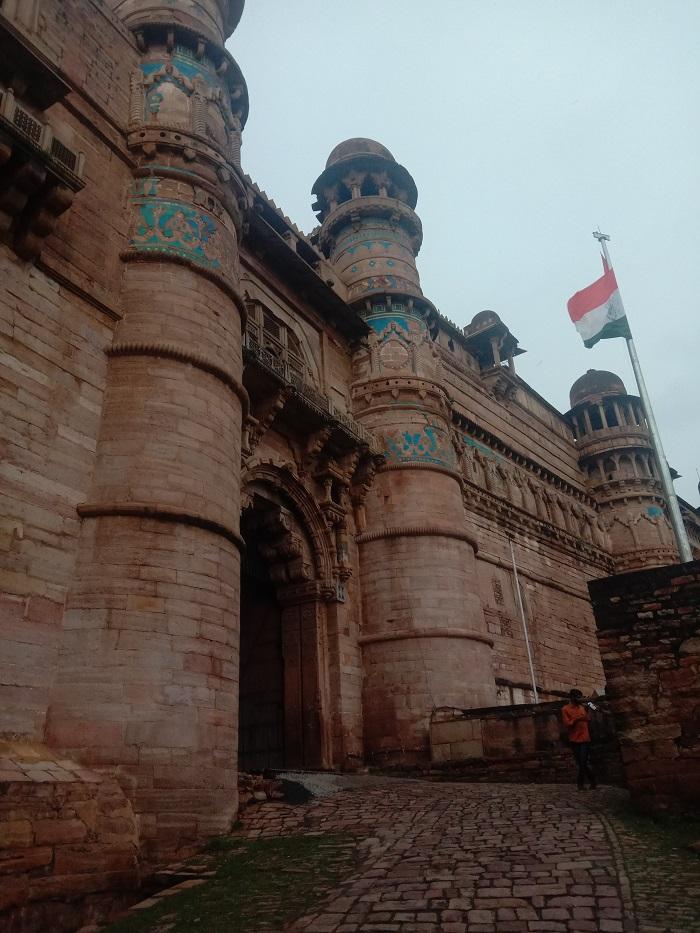
The Fort
Standing on a steep mass of sandstone, Gwalior Fort dominates the city and is its most significant monument. It has been the scene of momentous events, imprisonment, battles, and Jauhar’s. A steep road winds upwards to the fort, flanked by statues of the Jain Tirthankaras, carved into the rock face. The magnificent outer walls of the fort still stand, 3 km. in length and 10 m. high, bearing a reputation for being one of the most invincible forts of India. This imposing structure inspired Emperor Babur to describe it as ” the pearl amongst the fortresses of Hind “.
Within the fort premises, there are some marvels of medieval architecture. The 15th-century Gujari Mahal is made by Raja Mansingh Tomar for his Gurjar Queen, Mrignayani. The structure of Gujari Mahal has almost a total state of preservation- The Mahal converted into Archaeological Museum housing, some of them dating back to the 1st century A.D. Worth seeing is the statue of Shalbhanjika from Gyraspur, the tree goddess, the epitome of perfection in miniature. Sikh Guru Hargobind (the 6th guru), was kept captive at Assi Khamba Bawri near the Man Singh Palace in the 17th century during the rule of Jahangir. Man Mandir Palace, Gujari Mahal, Assi Khamba Ki Baoli, Jahangir Mahal, and Suraj Kund are other important monuments found within the fort complex.
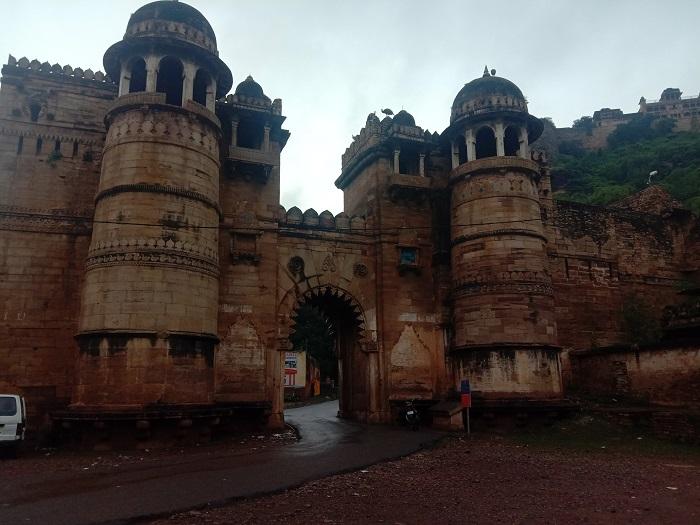
Monuments inside the Gwalior Fort complex
Gwalior fort complex also includes Jain temples form unique monuments inside the fort, with the Siddhachal Caves and Gopachal rock-cut Jain monuments. Jain Monuments consist of thousands of Jain Tirthankar idols destroyed during the Mughal invasion. The other famous Hindu temple in Gwalior includes the Teli ka Mandir, dedicated to lord Shiva, Vishnu, and Matrikas. Constructed in Dravidian style. On the other hand, the Chaturbhuj temple holds a position of significance because of its mathematical connection. you can be amazed to see that the second oldest reference to zero in mathematics is seen in a carving in the Chaturbhuj temple in the Fort of Gwalior. The inscription done in the Gwalior fort is about 1500 years old. The fort is as old as the 6th century.
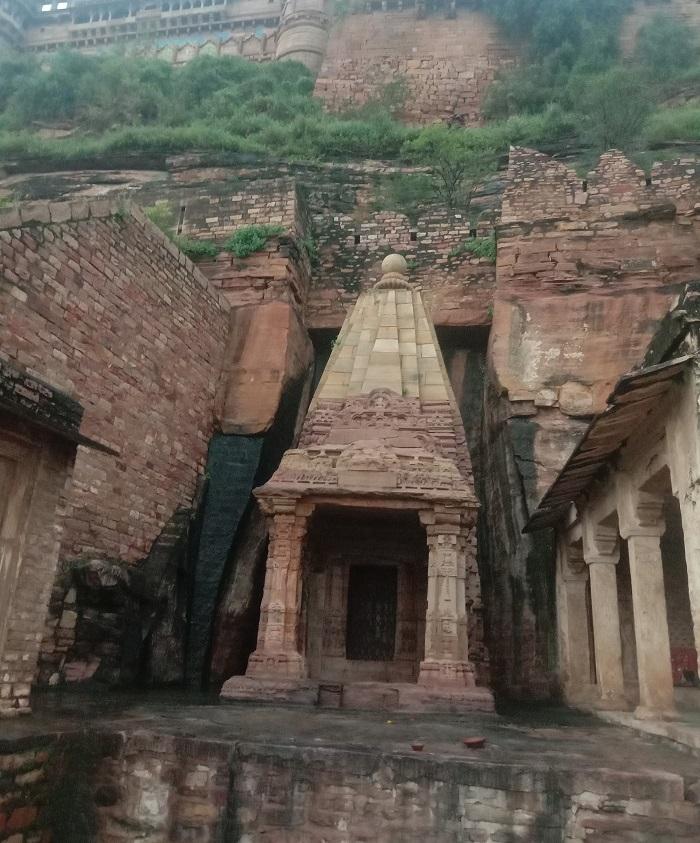
Melodic Gwalior and Tomb of Tansen
Gwalior holds an unpreceded taste and popularity in Hindustani Classical Sangeet and has retained Indian traditions and the wealth of music intact over the years. The Gwalior Gharana is one of the oldest and most prominent Khayal Gharanas. Legendary musicians like Tansen and Baiju Bawara belonged to Gwalior. Tansen was amongst the nine gems of Akbar’s court. who Discovered the Khayal classical sangeet. The melody of classical Indian music can be best viewed and witnessed in Tansen Samaroh which is organized to pay a tribute to the master of a musician of classical music, Tansen. The soul-stirring performances bring the evening alive. Every year, the event is organized from 26th- 30th Dec at different venues in Gwalior.
Also, read- Ultimate Trekking Experience-Singorgarh Fort and Rani Durgavati Sanctuary India
Light And Sound Show At Gwalior Fort
The light and sound show hosted every evening in the Fort of Gwalior, that Dazzle your eyes. When you will witness the show, it will seem that you are experiencing the history of the fort as the show is very well performed. The show also shows the love story of Raja Man Singh and queen Mrignayani. The show is conducted in the amphitheater in Man Mandir in both Hindi and English language.
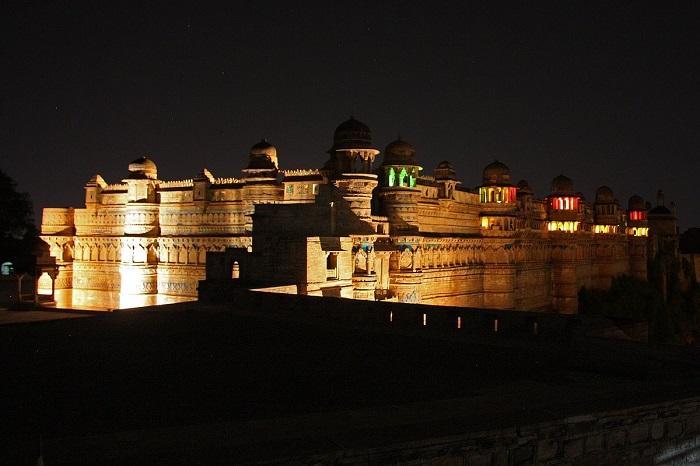
Jai Vilas Palace
The historic seat of the Scindia family, Jai Vilas palace is one of the grandest buildings in Gwalior. it is the symbol of the epitome of opulence and royalty. the palace was built by the then-ruler Jayaji Rao Scindia and reflects a beautiful Italian, and Corinthian style of architecture. Today, the palace is home to the descendants of the royal Scindia family. Out of the 400 rooms, 40 have been converted into the Jiwaji Rao Scindia Museum which is open to the public. The palace reflects the illustrious era of the Scindia dynasty.
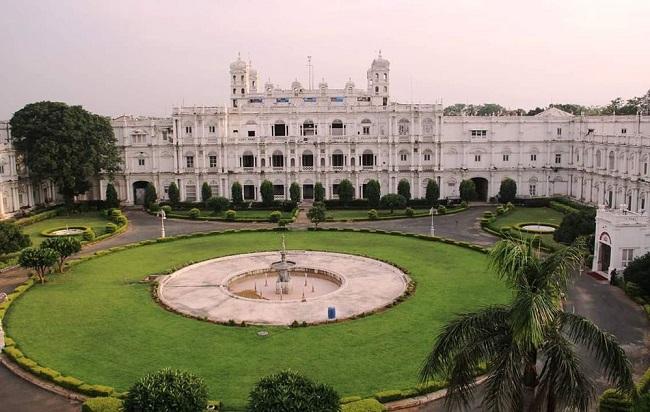
Gwalior Fort Timings And Entry Fee
Tourists can visit the Gwalior fort anytime from 6:00 AM morning till 5:30 PM in the evening. On average, it will take at least 3 to 4 hours to travel the entire Gwalior fort. Don’t miss the timings of the light and sound show which is indeed beautiful. The best time to visit Gwalior Fort is October to March and December and January.
How to Reach Gwalior Fort
Gwalior fort is easily reachable by air, train, and road network. it is well connected from New Delhi and Indore by air. Gwalior city on the main Delhi-Mumbai and Delhi-Chennai rail network. The super-fast Shatabdi express connects it daily to Delhi, Agra, Jhansi, and Bhopal. Gwalior is also well connected to the road network of all major cities of India.
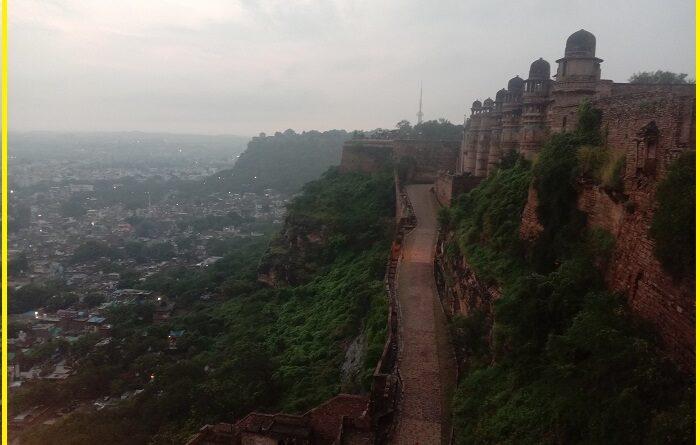

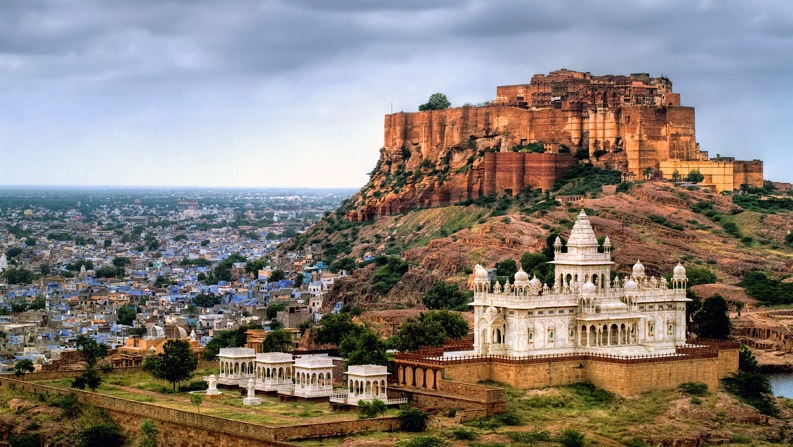

Pingback: ‘Chambal Ravines’ A bandland topography in the heart of Chambal river, Take a Geotourism around the unknown terrain - Geotourism